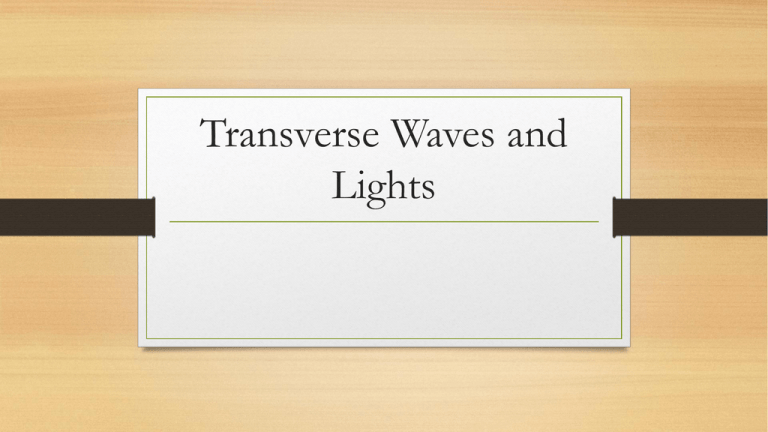Transverse Waves and Lights
advertisement

Transverse Waves and Lights Essential Question: What is a wave?(pg. 43) •Disturbance in matter than transfers energy from one place to another. What is the medium of a wave created by people at a sporting event? • People holding hands What is a medium? • The matter that the energy of mechanical wave travels through. Essential Question: What is a transverse wave? (pg. 45) • Wave in which the particles of the medium move/vibrate at right angles, or perpendicular to the direction that the wave travels. What is the lowest part of a transverse wave called? • The trough What part of the wave represents the energy in the wave? • The amplitude ( large amplitude; more energy) • Wavelength (shorter wavelength; higher energy • Frequency ( high frequency; high energy) Your Question: How do particles of the medium of a transverse wave vibrate? • They vibrate perpendicular to the direction the wave travels. Essential Question: What is frequency? (pg. 49) • The number of waves that pass a fixed point in a given amount of time. (measured in Hertz, Hz) What is the S.I. Unit for frequency? • Hertz (Hz) How does frequency affect wavelength? • Higher frequency means shorter wavelength. Your question: How are frequency, amplitude and wavelength related to energy of a transverse wave? • Higher frequency means more energy • Higher amplitude means more energy • Smaller/shorter wavelength mean more energy What factors affect the speed of waves? (pg. 51) • Frequency, wavelength, temperature, and type of medium When would a sound wave move fastest? The summer or the winter? • It would move faster in the summer, because the particles move faster due to the high temperature. Essential Question: What happens when a wave strikes a new medium? (pg. 55) • When a wave strikes a new medium it can either: Reflect: bounce back if it can’t pass through the medium. Refract: bend, because it travels at different speed through different medium. What is the law of reflection? • Angle of incidence equals to angle of reflection. What causes refraction to occur? • It occurs when waves enter through a medium at an angle. Waves bend as they travel through a medium, because they start travelling at a different speed in a new medium. Light wave hits the surface of the mirror at a 30 degree angle. Draw the angle of reflection and the angle of incidence. Essential Question: What is wave interference? (pg. 57) • Wave interference is when waves interact with each other. What is diffraction? What is reflection? • Diffraction: When waves spread out, travel around obstacles, or pass through an opening. • Reflection: when a wave hits a medium that it cannot pass through and therefore bounces back. What happens if two waves run into each other and their crests overlap? • They will create constructive interference (they will create a larger amplitude) Your Question: What is destructive interference? • Occurs when the crest of one wave overlaps the trough of the other wave. They cancel each other out or create a wave with lower amplitude. Essential Question: What is a light wave? (pg. 59) • Light wave is an electromagnetic wave. What creates an electromagnetic wave? • Charged particle vibrates causes the vibration of electric field creates a vibrating magnetic field two types of vibrating fields combine to form electromagnetic wave. What is different about electromagnetic wave and a regular mechanical transverse wave? • Electromagnetic wave can travel through empty space, but mechanical wave can only travel though a medium. Your Question: What is electromagnetic radiation? • It is the energy transferred by electromagnetic waves. Essential Question: Is light a wave or particle? (pg. 61) • Light can behave as both a wave and a particle. (it resembles a particle but moves like a wave) What is a photon? • A photon is packets of energy and tiny particles of light How fast is light? • Light travels at the speed of 3 * 10^8 m/s. What are the three types of matter? Explain the difference between them. • Transparent: Easily transmit light (allows most light to pass though). Ie. glass • Translucent: It transmits and scatters light at the same time (allows some light to pass through). Ie. Frosted window • Opaque: It does not transmit light (no light can pass through). Ie. Aluminum foil Your Question: What are the three things that could happen when light strikes a matter? • Reflection, absorption, or transmission Essential Question (pg. 67): What is a mirror? • Object made of glass that reflects all the light that strikes it. What type of image do you get from a plane mirror? • Virtual and reversed image Your Question: What is the difference between a convex lens and concave lens? • Convex lens: is thicker in the middle and thinner at the edges (form an image that is larger than the real object) • Concave lens: thinner in the middle and thicker and the edges (forms an image that is smaller than the real object. A disturbance in matter that transfers energy from on place to another • Mechanical Wave The matter that mechanical energy travels through •Medium Particles of the matter move perpendicular to the direction the wave travels • Transverse Wave The high points of the wave • Crests The low points of the wave • Trough Maximum distance the particles of the medium move from their resting position when a wave passes through. • Amplitude Where the particles of the medium are in the absence of wave • Resting position The distance between two corresponding points on adjacent waves • Wavelength




